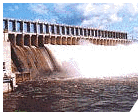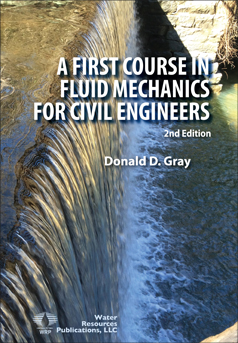

 |
 |
||||||
 Used by major universities, this is an excellent textbook for teaching introductory courses in fluid mechanics for civil engineering students |
Title: A First Course in Fluid
Mechanics for Civil Engineers - 2nd Edition NEW REVIEWS -- From the TABLE OF CONTENTS One of the greatest pleasures of fluid mechanics comes from learning how to use mathematics to describe the physical world. Donald D. Gray
|
A First Course in Fluid Mechanics for Civil Engineers 2nd Edition, this 2nd edition has been extensively revised to incorporate both the years of classroom experience by the author and also to address current approaches to fluid mechanics. This 2nd Edition contains many new examples and more than triple the number of homework problems. It is specifically intended as a textbook for a one semester introduction to fluid mechanics. Some distinctive features make this book ideal for students of civil engineering and related fields such as environmental, ecological, and agricultural engineering:
|
-> Emphasis on the head concept throughout the text. -> Emphasis on the importance and limitations of the parallel flow assumption, based on the Euler equation in natural coordinates. -> Development of the conservation equations using the easily understood balance principle rather than the needlessly abstract Reynolds Transport Theorem. -> Careful distinction between the ideal Bernouli equation and the mechanical energy equation with loss terms. -> Use of the total and piezometric head lines for the qualitative analysis of pipe flows. -> Use of the latest Crane techniques for minor losses in pipe flows. -> Clarification of when to use gage pressure or absolute pressure in the momentum equation. |
-> Use of three-dimensional specific head function plots to explain alternate and critical depths in open channels. -> Explanation of when the Manning equation is valid and when the friction factor method must be used in open channel computations. -> Use of the easily understood Ipsen method for dimensional analysis. -> Interpretation of dimensionless numbers as time ratios as well as the traditional force ratios. -> Interpretation of dimensionless numbers as time ratios as well as the traditional force ratios. -> Chapter on physical hydraulic models, including distorted models. -> The book contains many examples worked in detail as well as numerous homework problems, some requiring the use of the computer. A solutions manual is available to instructors. |
REVIEWS [top]
"A civil engineering student who reads this textbook in his or her first course in fluid mechanics will indeed find it readabale and exciting." and "This book is also to be recommended for teaching fluid mechanics for civil engineers."
Hector R. Bravo, Review Published in Journal of Hydraulic Engineering, Vol. 127, No. 1, January 2001
"Overall, the book is well written and should be considered for adoption in civil engineering programs." Also,
"The separation of topics into multiple chapters may make it easier to organize the material for classes of different levels." And,
"Overall, Gray's text is a welcome addition to a civil
engineering faculty member's bookshelf. Students will appreciate
the easy-to-read style with civil engineering applications."
Richard H. McCuen, AWRA Book Reviews, Oct. 20, 00, see:http:
//www.awra.org/books/0010awra/book3.html
|
1.1 - The Scope of Fluid Mechanics 1.2 - Fluid Mechanics in Engineering 1.3 - Units 1.4 - Annotated Bibliography 1.5 - Homework Problems Chapter 2 - FLUID PROPERTIES 2.1 - The Molecular Basis of Fluid Behavior 2.2 - Properties Related to Mass 2.3 - The Perfect Gas Law 2.4 - Viscosity 2.5 - Homework Problems 2.6 - Bibliography Chapter 3 - HYDROSTATICS 1 3.1 - Stress 3.2 - Pascal’s Law 3.3 - Variation of Pressure 3.4 - Pressure Variation in a Compressible Gas 3.5 - The Ideal Barometer 3.6 - The Real Barometer: Vapor Pressure and Surface Tension 3.7 - Absolute Pressure and Gage Pressure 3.8 - Piezometers and Piezometric Head 3.9 - Manometers 3.10 - Other Devices for Measuring Pressure 3.11 - Homework Problems 3.12 - References Chapter 4 - HYDROSTATICS 2 4.1 - Hydrostatic Thrust 4.2 - Hydrostatic Thrust on Plane Areas 4.3 - Examples 4.4 - Hydrostatic Thrust Due to Layered Fluids: The Imaginary Free Surface 4.5 - Homework Problems Chapter 5 - FUNDAMENTALS OF FLUID DYNAMICS 5.1 - Kinematics of Flow 5.2 - The Euler Equation 5.3 - The Euler Equation in Natural Coordinates 5.4 - Forced and Free Vortices 5.5 - The Bernoulli Equation 5.6 - The Ideal Free Jet 5.7 - The Pitot and Pitot Static Tubes 5.8 - Flowrate and the Streamtube Continuity Equation 5.9 - Differential Head Flowmeters and Cavitation 5.10 - The High Velocity Cutting Jet 5.11 - The Siphon 5.12 - Steady and Unsteady Flow 5.13 - Sharp Crested Weirs 5.14 - The Euler Equation in Rectangular Coordinates 5.15 - Homework problems 5.16 - References Chapter 6 - THE PRINCIPLE OF BALANCE AND THE CONTINUITY EQUATION 6.1 - Flowrates of Any Quantity 6.2 - The Principle of Balance 6.3 - The Continuity Equation 6.4 - The Reducing Bend 6.5 - The Mixing Tank 6.6 - The Conical Reducer 6.7 - Filling a Tank with Compressed Gas 6.8 - Water Tank Transients 6.9 - The Draining Tank 6.10 - The Continuity Equation at a Point 6.11 - Homework Problems 6.12 - References Chapter 7 - LAMINAR FLOW 7.1 - Viscosity 7.2 - Couette Flow Viscometry 7.3 - Laminar Pipe Flow 1 7.4 - The Navier - Stokes Equation in Rectangular Coordinates 7.5 - Homework Problems 7.6 - References |
8.1 - The Energy Balance for a Control Volume 8.2 - The Mechanical Energy Equation 8.3 - The Bernoulli Equation vs. the Mechanical Energy Equation 8.4 - The Piezometric Head Line and the Total Head Line 8.5 - Homework Problems 8.6 - References Chapter 9 - PIPE FLOW 1 9.1 - The Friction Factor in Laminar Pipe Flow 9.2 - Reynolds’ Experiment 9.3 - Turbulent Flow and the Reynolds Decomposition 9.4 - Homework Problems 9.5 - References Chapter 10 - DIMENSIONAL ANALYSIS 10.1 - Dimensional Homogeneity and the Method of Ipsen 10.2 - The Buckingham Pi Theorem 10.3 - Dimensionless Numbers and Their Physical Meaning 10.4 - Homework Problems 10.5 - References and Bibliography Chapter 11 - PIPE FLOW 2 11.1 - The Friction Factor in Turbulent Pipe Flow 11.2 - Simple Pipe Problems 11.3 - Minor Losses 11.4 - Pipes in Series 11.5 - Flow of Gases in Pipes 11.6 - Flow in Noncircular Conduits 11.7 - Homework Problems 11.8 - References Chapter 12 - THE MOMENTUM EQUATION 12.1 - The Momentum Equation 12.2 - Force on a Vane 12.3 - Force on a Reducing Bend 12.4 - Force on a Sluice Gate 12.5 - Starting Flow in a Pipe 12.6 - Homework Problems 12.7 - References Chapter 13 - OPEN CHANNEL FLOW 13.1 - The Nature of Open Channel Flow 13.2 - Uniform Flow: The Manning Equation 13.3 - Uniform Flow: The Friction Factor Method 13.4 - Specific Head 13.5 - Gradually Varied Flow 13.6 - Gravity Waves in Open Channels 13.7 - Homework Problems 13.8 - References Chapter 14 - HYDROSTATICS 3 14.1 - Hydrostatic Thrust on Curved Surfaces 14.2 - Buoyancy 14.3 - Stability 14.4 - Homework Problems 14.5 - References Chapter 15 - PHYSICAL MODELS AND SIMILARITY 15.1 - Scale Model Testing 15.2 - Incomplete Similarity 15.3 - Distorted Models 15.4 - Movable Bed Models 15.5 - Homework Problems 15.6 - References and Bibliography Appendix A. - - TABLES OF FLUID PROPERTIES Appendix B. - THE GREEK ALPHABET Appendix C. - UNCERTAINTY AND SIGNIFICANT DIGITS Appendix D. - ANSWERS TO SELECTED HOMEWORK PROBLEMS Subject Index |
If you are planning to teach an introductory course in fluid mechanics for civil engineering students we invite you to consider this book. To request an examination copy either send a request on your university letterhead to WRP, P.O. Box 630026, Highlands Ranch, Colorado 80163-0026 or fax it to 720-873-0173. Second Edition 2016 WRP.
© Copyright 2021. Water Resource Publications, LLC. All
rights reserved.
Colorado, USATelephone: 720-873-0171 / Fax: 720-873-0173
E-mail:
